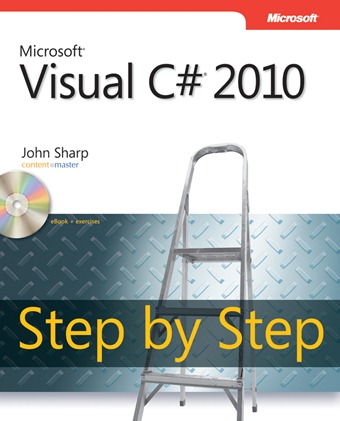RTM’d today: Microsoft Visual C# 2010 Step by Step
 We’re pleased to announce that John Sharp has revised his Visual C# Step by Step book: Microsoft Visual C# 2010 Step by Step went to the printer today! (You can read reviews of the previous edition of John’s book at Amazon.)
We’re pleased to announce that John Sharp has revised his Visual C# Step by Step book: Microsoft Visual C# 2010 Step by Step went to the printer today! (You can read reviews of the previous edition of John’s book at Amazon.)
Take a look at what the book offers:
Contents at a Glance
Part I Introducing Microsoft Visual C# and Microsoft Visual Studio 2010
1 Welcome to C# . 3
2 Working with Variables, Operators, and Expressions . 27
3 Writing Methods and Applying Scope . 47
4 Using Decision Statements . 73
5 Using Compound Assignment and Iteration Statements 91
6 Managing Errors and Exceptions . 109
Part II Understanding the C# Language
7 Creating and Managing Classes and Objects . . . . . . . . . . . . . . . 129
8 Understanding Values and References . 151
9 Creating Value Types with Enumerations and Structures 173
10 Using Arrays and Collections 191
11 Understanding Parameter Arrays 219
12 Working with Inheritance . 231
13 Creating Interfaces and Defining Abstract Classes . 253
14 Using Garbage Collection and Resource Management 279
Part III Creating Components
15 Implementing Properties to Access Fields . 295
16 Using Indexers 315
17 Interrupting Program Flow and Handling Events . 329
18 Introducing Generics . 353
19 Enumerating Collections . 381
20 Querying In-Memory Data by Using Query Expressions . 395
21 Operator Overloading . 419
Part IV Building Windows Presentation Foundation Applications
22 Introducing Windows Presentation Foundation . 443
23 Gathering User Input . 477
24 Performing Validation . 509
Part V Managing Data
25 Querying Information in a Database 535
26 Displaying and Editing Data by Using the Entity
Framework and Data Binding 565
Part VI Building Professional Solutions with Visual Studio 2010
27 Introducing the Task Parallel Library 599
28 Performing Parallel Data Access 649
29 Creating and Using a Web Service 683
Appendix: Interoperating with Dynamic Languages . 717
And here’s part of the book’s Introduction:
Introduction
Microsoft Visual C# is a powerful but simple language aimed primarily at developers creating
applications by using the Microsoft .NET Framework. It inherits many of the best features of
C++ and Microsoft Visual Basic, but few of the inconsistencies and anachronisms, resulting
in a cleaner and more logical language. C# 1.0 made its public debut in 2001. The advent of
C# 2.0 with Visual Studio 2005 saw several important new features added to the language,
including Generics, Iterators, and anonymous methods. C# 3.0 which was released with
Visual Studio 2008, added extension methods, lambda expressions, and most famously of
all, the Language Integrated Query facility, or LINQ. The latest incarnation of the language,
C# 4.0, provides further enhancements that improve its interoperability with other languages
and technologies. These features include support for named and optional arguments, the
dynamic type which indicates that the language runtime should implement late binding for
an object, and variance which resolves some issues in the way in which generic interfaces are
defined. C# 4.0 takes advantage of the latest version of the .NET Framework, also version
4.0. There are many additions to the .NET Framework in this release, but arguably the most
significant are the classes and types that constitute the Task Parallel Library (TPL). Using the
TPL, you can now build highly scalable applications that can take full advantage of multi-core
processors quickly and easily. The support for Web services and Windows Communication
Foundation (WCF) has also been extended; you can now build services that follow the REST
model as well as the more traditional SOAP scheme.
The development environment provided by Microsoft Visual Studio 2010 makes all these
powerful features easy to use, and the many new wizards and enhancements included in
Visual Studio 2010 can greatly improve your productivity as a developer.
Who This Book Is For
This book assumes that you are a developer who wants to learn the fundamentals of
programming with C# by using Visual Studio 2010 and the .NET Framework version 4.0. In
this book, you will learn the features of the C# language, and then use them to build
applications running on the Microsoft Windows operating system. By the time
you complete this book, you will have a thorough understanding of C# and will have
used it to build Windows Presentation Foundation applications, access Microsoft
SQL Server databases by using ADO. NET and LINQ, build responsive and scalable
applications by using the TPL, and create REST and SOAP Web services by using WCF.
Watch for detailed excerpts from the book here in the future.